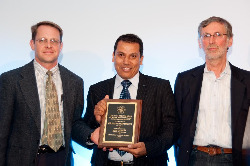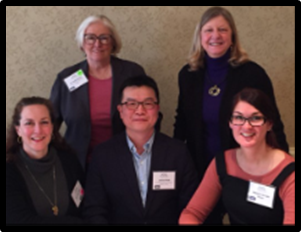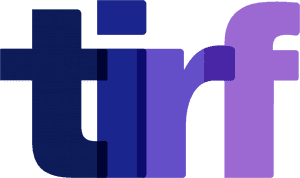You may have seen Ryan Damerow’s announcement in the November 2020 issue of TIRF Today that I was being honored by AAAL (the American Association for Applied Linguistics) with the 2021 Distinguished Scholarship and Service Award. This was a tremendous honor but also an overwhelming responsibility, because receiving the award involved giving a talk at the virtual conference. I had no idea what to talk about and suffered from three months of “speaker’s block” before I finally got an idea. As 2021 marks forty years since I started working here at MIIS, I decided to think about the past four decades of working as an applied linguist. I called the talk, “Lessons Learned: Forty Years of Applying Applied Linguistics.”
Preparing for the presentation entailed a great deal of thought and reflection. It wasn’t going to be a research report, nor was I promoting a research method. I wasn’t reviewing a body of literature or espousing a particular theoretical position. Instead, I was just sharing some reflections, and in today’s Chair’s Report, I’d like to share with you five lessons I’ve learned.
Let me start by sharing a statement about applied linguistics from the AAAL website:
Applied linguistics addresses a broad range of real-life, language-related issues by developing its own knowledge base about language, its users and uses, and their underlying social and material conditions. This interdisciplinary field relates to education, psychology, communication research, anthropology, and sociology, among many others.
As you can see, applied linguistics as a profession and a discipline, encompasses concerns that parallel TIRF’s mission. Given this background, here are my thoughts about some of what I’ve learned.

The 1st Lesson: Life Is What Happens
In the lyrics to “Beautiful Boy,” John Lennon wrote, “Life is what happens to you while you’re busy making other plans.” It strikes me that many of my own professional plans have changed so much that as a 21-year-old in college, just spreading my wings, I could not possibly have imaged where I would land. By way of introducing the lessons I’ve learned, let me share with you a bit of personal history.
When I finished my BA in English literature and my secondary school teaching credential, my plan was to teach literature in California high schools. But getting married to a US soldier (one of the last draftees at the end of the Vietnam war) took me to Uijeongbu in South Korea.
There I taught remedial reading courses to military personnel who had not yet finished their high-school education. Some of the soldiers in the 2nd Infantry Division did not have the reading skills to complete the basic curriculum that would prepare them to take the exam to get their General Equivalency Diploma. I was ill-equipped to teach remedial reading, but two factors led me to a career change while I was in Korea. First, the director of the program I taught in, Dr. Art Picard, had completed the TESL Certificate at UCLA (University of California Los Angeles), and he encouraged me to apply for admission there. Second, living in the village and learning some survival Korean gave me a deep appreciation for the challenges faced by adult language learners who find themselves immersed in a new country with no proficiency in the local language.
I followed Dr. Picard’s advice, and was admitted to UCLA’s TESL Certificate Program. At that point, my plan was to get training to teach ESL to adult immigrants and refugees in the US. But in that first year, I became fascinated by research and decided to continue for the MA degree. One thing led to another and fascination changed to passion, so I applied to the new interdisciplinary PhD program in applied linguistics at UCLA.
When I finished my doctorate, I wanted to do classroom research on second language acquisition. I was applying for tenure-track jobs at research universities and was shortlisted for three such positions when I got a mystery phone call from someone I’d never met about a job I was unaware of at a school I’d never heard of. Going for that interview led me to my dream job at MIIS – which involved yet another change of plans!
Instead of conducting classroom research, I found myself chairing a new MA TESOL Program. My responsibilities included building a library collection, teaching nine new courses in the first year, proposing and defending a program budget, hiring adjunct faculty members, and recruiting and advising students. I was prepared academically, but not for the wider social and political issues of engaging in governance, finding new faculty allies, and competing for scarce resources.
The punch line is that plans change, but fortunately there are many ways and many different contexts in which we can apply applied linguistics. This point leads to the second lesson.
The 2nd Lesson: Intersecting Pathways
As you may know from previous Chair’s Reports in TIRF Today, I like to think in metaphors, and of course the idea of life as a journey is a very familiar image. Today I want to think about our modes of transportation as we make that journey: Life as an applied linguist is not lived on a railroad track or a freeway. We’re not riding a zip line or a tram.
Metaphorically speaking, applying applied linguistics involves a series of intersecting pathways, which will sometimes lead us to unexpected but sometimes related destinations. For example, even though my path has taken many turns, preparing to teach literature helped me grow and sustain my love of beautiful writing. I never did get to teach literature, but teaching remedial reading for the US Army and learning a bit of survival Korean led me to UCLA, where I became a researcher while maintaining my love of teaching. While I was pursuing tenure-track jobs at research universities (the plan), I unexpectedly found my (non-tenure) dream job. (Actually, it found me.) Teacher education became my main work. Program administration became a necessity.

After forty years at MIIS, I can look back with few regrets about where my path has taken me. And this point leads to the third lesson.
The 3rd Lesson: Building Our Legacies
As teachers, researchers, program administrators, teacher educators, curriculum designers, textbook authors, test developers, mentors, translators/interpreters, and/or policymakers – whatever career path we take – we all build our own legacies.
The records, results, and memories of our work both precede us and outlast us. Colleagues and students may read what we have written long before we meet and long after we are gone.
For example, when I first joined the Executive Committee (EC) of AAAL in 2013, I met Lucy Pickering (another new member of the EC). When I commented on some research about international teaching assistant, Lucy said, “Oh, you’re THAT Bailey!” (referring to research I had done in the early 1980s).

Dr. Blair Bateman, TIRF Grantee Dr. Muhammad Abdel Latif, and Dr. Leo van Lier
Many authors and leaders whose work has influenced me (through their teaching, their publications, their conference presentations, and their volunteer service) are no longer living. They include Jim Alatis, Ed Anthony, Russ Campbell, Antonieta Celani, Craig Chaudron, Bob Cullen, David Graddol, Dell Hymes, Braj Kachru, Wally Lambert, Mike Long, Terry Pica, Wilga Rivers, Charlie Sato, Jackie Schachter, Dick Schmidt, Leo van Lier, and Cyril Weir. Their work lives on, through their research and the results of their service.
Thinking about the way each of these applied linguists lived their lives leads me to the fourth lesson.
The 4th Lesson: Stepping Outside
Applying applied linguistics can and should happen both inside and outside of our usual workplace. On its website, AAAL promotes applied linguistics “in the academy and in society.” In a parallel philosophy, TIRF’s mission (as shown on our website) is “to promote research and best practices that inform and enrich English language education in multilingual contexts.” To do so, “TIRF applies research findings to practical language problems by working collaboratively with teachers, researchers, authors, publishers, philanthropic foundations, government agencies, and major companies.”
As language professionals, we need to have the confidence to step outside of our comfort zones. Leaving the classroom, the office, the laboratory, the library, or the “Zoom room” in order to apply applied linguistics can involve many different endeavors, including both paid work and volunteer efforts.
Paid opportunities will depend on our areas of expertise and our locations and/or citizenship. But such opportunities can include doing program evaluations, developing language tests, conducting studies and research training programs, and offering teacher training workshops. There are so many ways to apply applied linguistics!
Volunteering can also lead to new challenges, skills development, conference presentations and other speaking engagements, chapter or book contracts, opportunities to edit, consulting jobs, travel possibilities, and – perhaps most importantly – new colleagues and friends.

Here is an example. This photo was taken at a roundtable presentation at the 2015 AAAL Conference in Toronto. The topic was English as a Medium of Instruction and the three presenters (seated in the front row, from left to right) are Joyce Kling (Denmark), Jaehan Park (Korea), and Melanie van den Hoven (United Arab Emirates). All three of these up-and-coming researchers had been TIRF grantees. TIRF Trustee Jodi Crandall and I (standing behind the three presenters) were fortunate to be able to attend their session at the AAAL Conference, where they met for the first time.
Whether we step out of our comfort zones by running a program, a school, or a professional organization, by conducting research, by starting a new journal or book series, or by attending and organizing conferences, we need funding. This issue leads to the fifth lesson.
The 5th Lesson: Finances and Fundraising
This last lesson may seem rather strange, but I firmly believe it is important that applied linguists know about finances and fundraising. Whether we are writing grant proposals, establishing scholarships, negotiating employees’ contracts or our own contracts, developing departmental budgets, securing funding for our start-up programs, or convincing policymakers of the need for support, we must be able to think logically and communicate convincingly about financial issues.

I’m sure you see where this last lesson is going.
Everything I’ve learned about fundraising I’ve learned through volunteer service with TESOL, AAAL, and TIRF. I will admit, fundraising for TIRF is the most challenging volunteer activity I’ve ever undertaken. So, in closing this Chair’s Report, I will repeat a very familiar refrain: Please, if you can, support TIRF with a donation. Every penny we raise is put to good use, and we are very frugal about expenditures. As you can see from the report about our March 2021 Board meeting, the Trustees are all actively involved as volunteers. They are engaged in exciting initiatives which will involve applying applied linguistics in many creative and impactful ways.
Best wishes,


